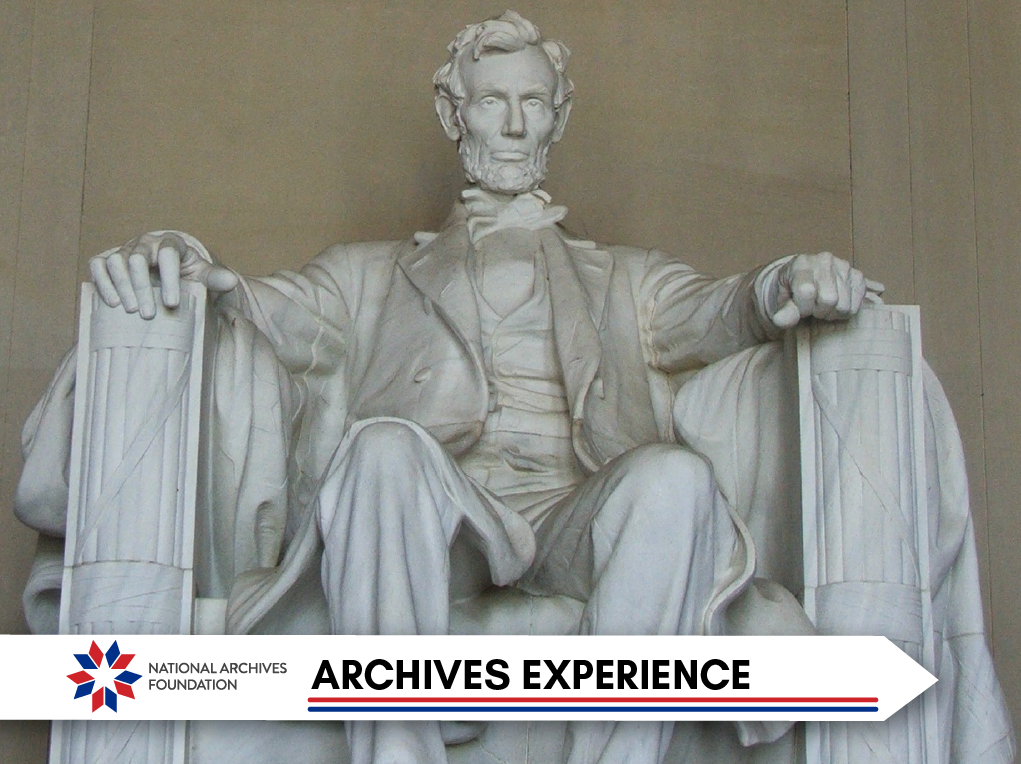Archives Experience Newsletter - June 6, 2023
The Long Road to Abolition
There are some events in history that are so enormous that it’s easy to talk about them in isolation: signing the Declaration, Pearl Harbor, putting a man on the moon. The stories often take on a life of their own, and what’s lost is all of the small events that got us to this monumental place. The issuing of the Emancipation Proclamation is certainly one of them.
Slavery was a continuous source of conflict and a moral debate since our nation’s founding, when tensions finally boiled over inciting the Civil War. The Emancipation Proclamation was one of the final steps in putting an end to the brutal system.
The Emancipation Proclamation is a seminal document, but this week, we’re highlighting the lesser-known documents that preceded it.
History Snack
In 1619, the English privateer White Lion brought 20 enslaved Africans to Jamestown, Virginia, thus introducing the institution of slavery to the Northern Hemisphere. In November of the next year, the Mayflower landed off what is now Massachusetts, with 102 Puritans passengers who established the Plymouth Colony. It seems natural to think that the Puritans, who came to the Americas seeking religious freedom—at least for themselves—would have opposed slavery. Unfortunately, not all of them did.
According to Wendy Warren, author of New England Bound: Slavery and Colonization in Early America, throughout the 17th century, many colonists enslaved both Africans and Native Americans all across New England. Still, many of their neighbors were opposed to slavery. Samuel Sewell, the first justice of the Massachusetts Superior Court, published the first anti-slavery pamphlet, “The Selling of Joseph,” in 1700. Years before, Sewell had been involved in the Salem witch trials and had then publicly recanted his participation. In his pamphlet, Sewell states that it is wrong to be bringing enslaved people to Boston, that slavery is not God’s work.
Perhaps not surprisingly, Sewell’s work had little immediate impact on slavery in Massachusetts. Nevertheless, more citizens of New England embraced abolitionist positions as time went on. Vermont abolished slavery on July 2, 1777, less than a year after the Declaration of Independence had been read to the public in Philadelphia.
1780
Well before the Revolutionary War was won, Pennsylvania became the first state to pass an act that gradually abolished slavery.
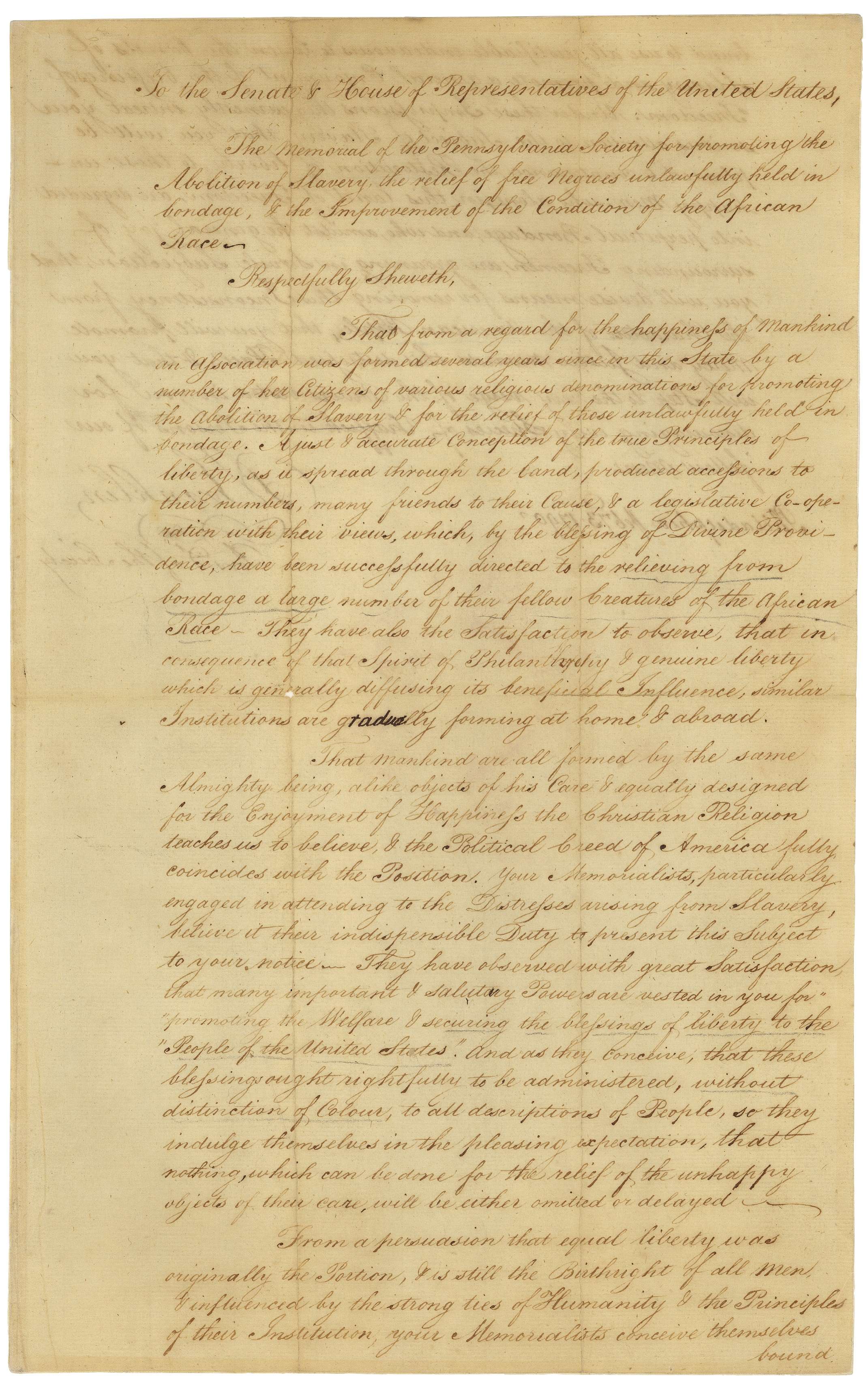
Pennsylvania Society letter
Source: NARA’s DocsTeach
Then in 1790, Benjamin Franklin sent a letter to Vice President John Adams, enclosing with it a letter from James Pemberton and a petition from the Pennsylvania Society for Promoting the Abolition of Slavery. The First U.S. Congress was the intended recipient of the letters and the petition, to which the Pennsylvania Society, Philadelphia and New York Yearly Meetings of the Society of Friends (Quakers), and the Pennsylvania Society for Promoting the Abolition of Slavery had been resolutely sending anti-slavery petitions as part of the first unified abolition campaign in American history.
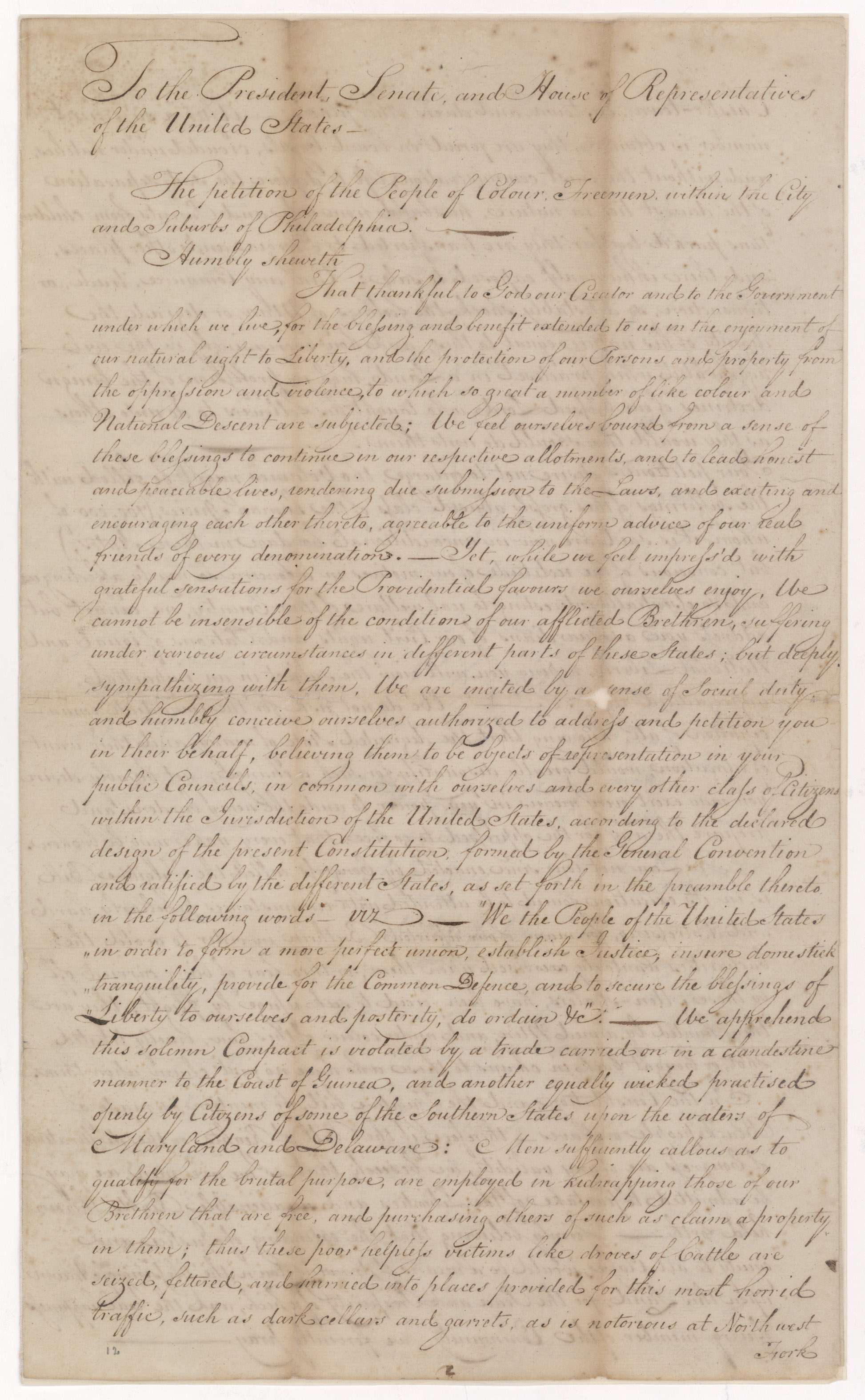
Free Blacks of PA petition
Source: NARA’s DocsTeach
Ben Franklin signed the petition from the Pennsylvania Society on February 3, 1790, which called on Congress to “devise means for removing the Inconsistency from the Character of the American People” and to “promote mercy and justice toward this distressed Race.” Despite the fierce debate that all three petitions generated in the House and the Senate, the issue died in committee.
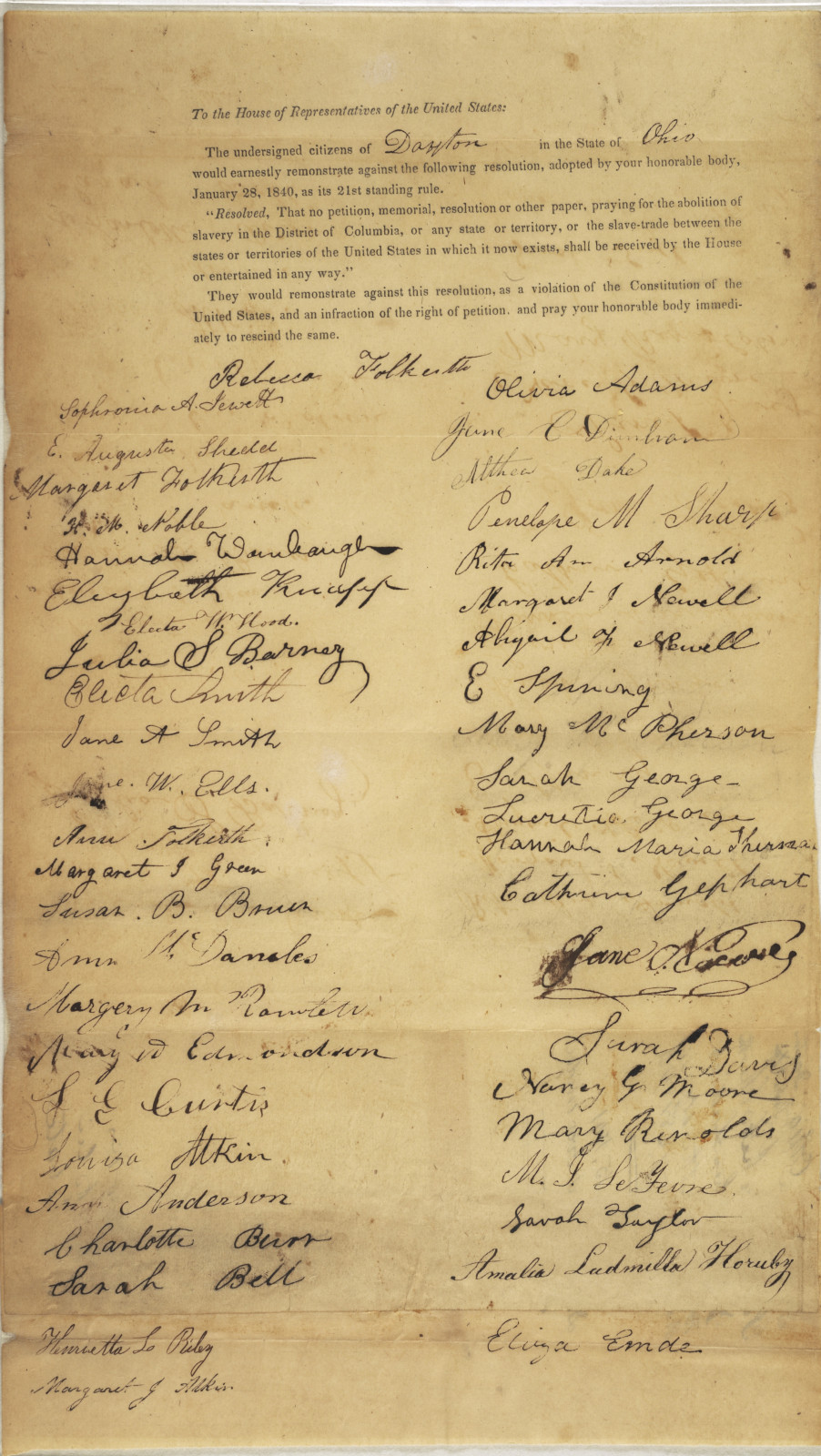
Dayton, OH petition
National Archives Identifier: 66539417
On December 30, 1799, the Reverend Absalom Jones and other free blacks of Philadelphia petitioned Congress, complaining that under the new fugitive slave law, Southerners were kidnapping free Blacks and selling them into slavery in Southern states. They also stated that they hoped slavery could be done away with, saying, “We do not ask for the immediate emancipation of all…yet humbly desire you may exert every means in your power to undo the heavy burdens, and prepare the way for the oppressed to go free….” However, because the issue of slavery was an integral part of the Constitution, only the portions of the petition that concerned fugitive slaves or the slave trade from the U.S. to foreign places were referred to the committee, where the resolution of referral was amended.
As new states with anti-slavery constitutions entered the union, slave owners in Southern states were both unnerved and enraged. They clearly saw the handwriting on the wall—their livelihoods and their way of life were endangered because the opportunity to expand slavery into neighboring states was being shut down.
1802
Ohio entered the union with a constitution that outlawed slavery
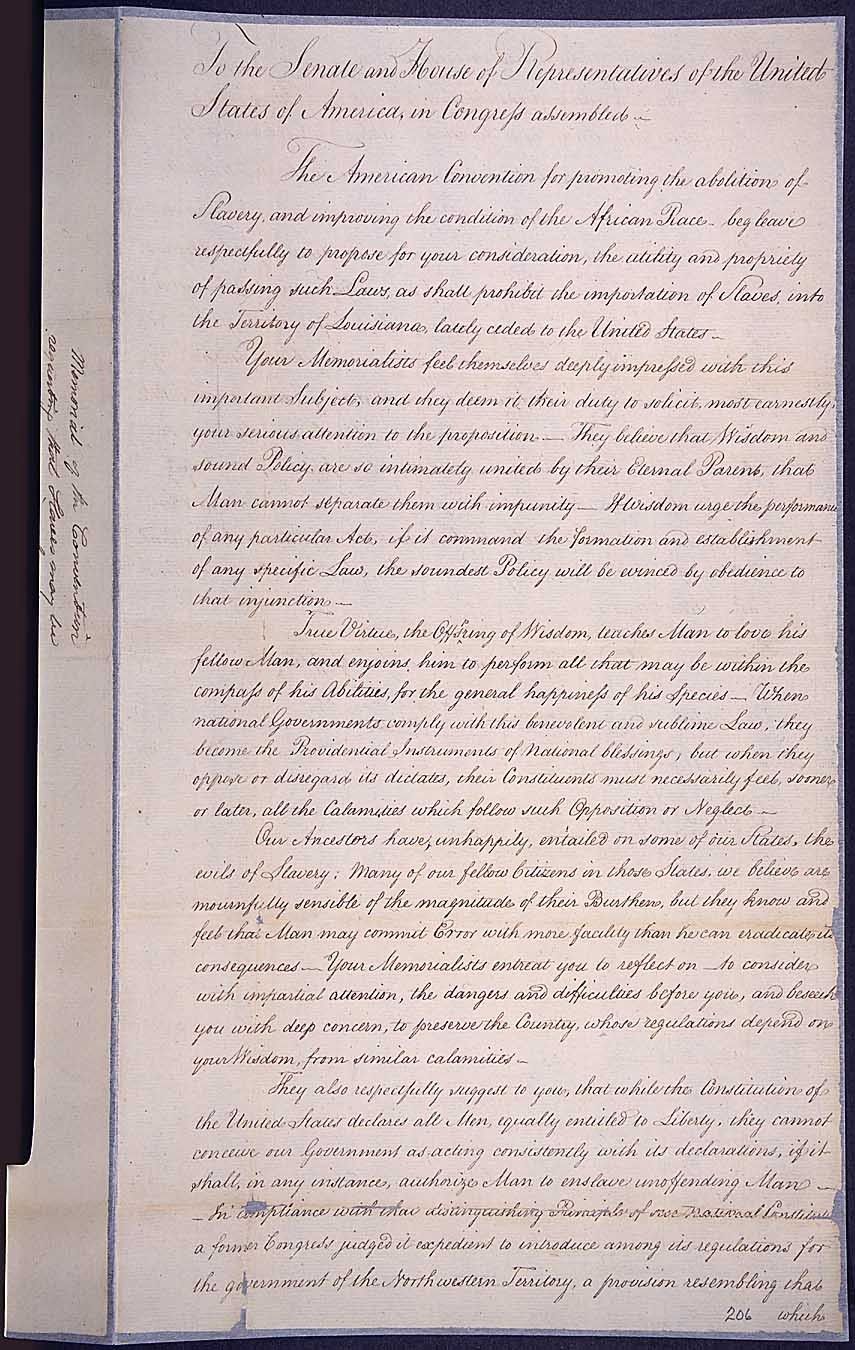
Petition to prohibit slavery in the Louisiana Territory
Source: NARA’s DocsTeach
On January 26, 1804, the American Convention for the Abolition of Slavery asked Congress to prohibit the importation of slaves into Louisiana
1816
Indiana entered the union with a constitution that clearly prohibited slavery and involuntary servitude
In the mid-1800s, anti-slavery petitions came to Congress thick and fast, as this ledger from 1836 shows. On July 13, 1836, the Boston Female Anti-Slavery Society implored the women of Massachusetts as women, wives, mothers, sisters, and daughters to unite in opposing slavery in the nation. The address specifically appealed for the abolition of slavery in the nation’s capital, the District of Columbia.
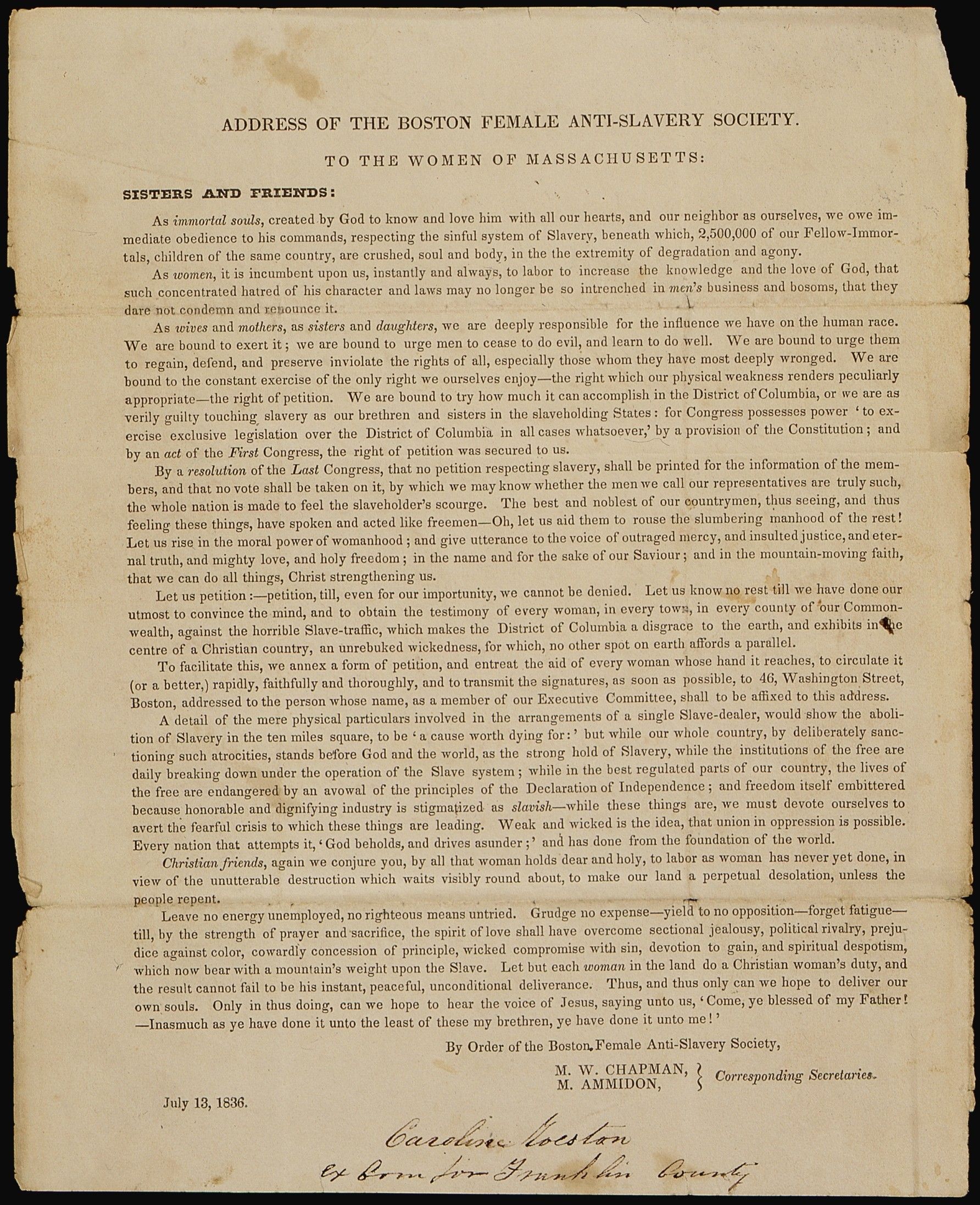
Boston anti-slavery petition
Source: NARA’s DocsTeach
In 1844, the 28th Congress received a petition from Pennsylvanians, who asked it to abolish slavery and not admit any new states to the union that sanctioned slavery.
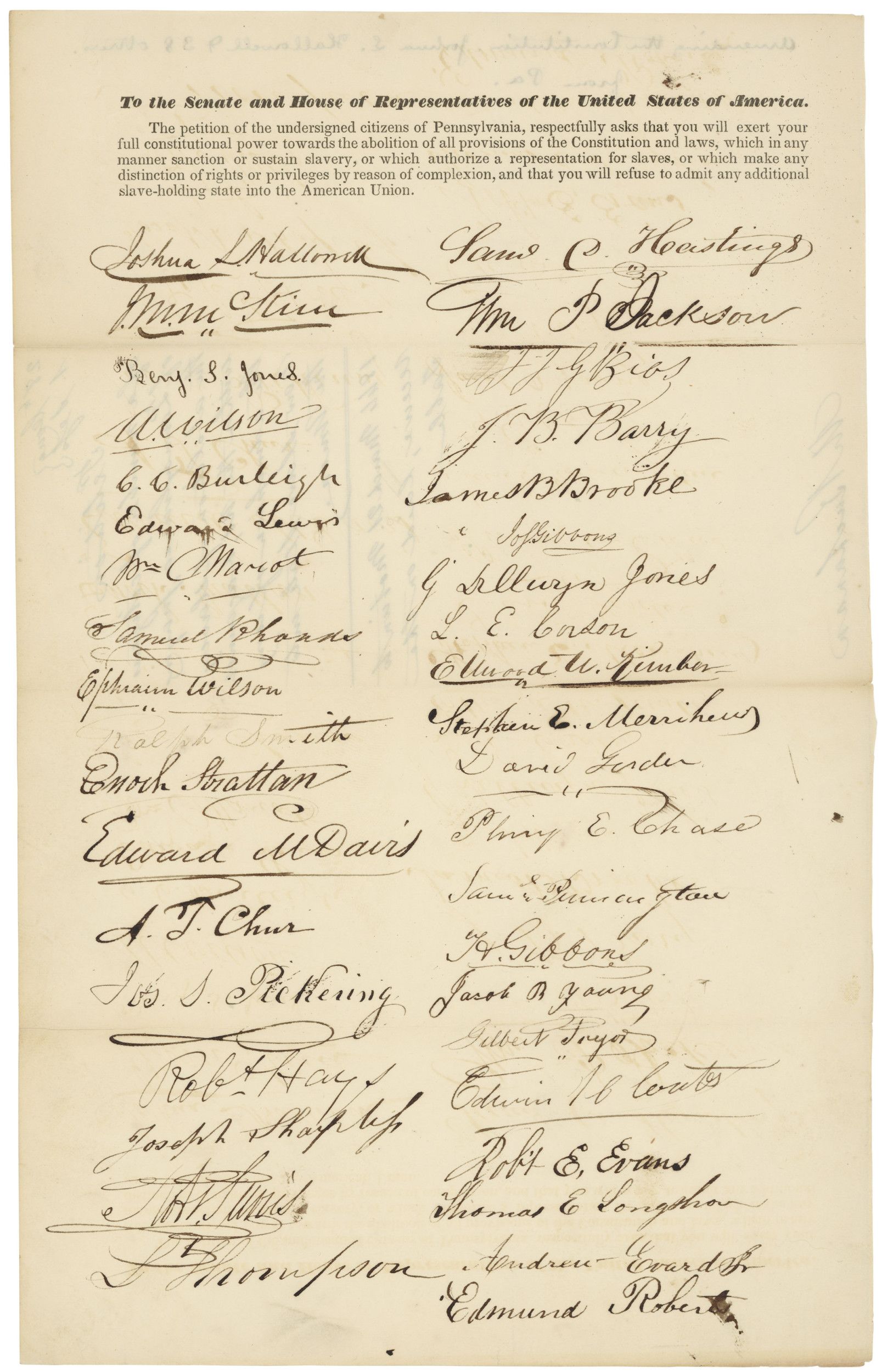
Petition to prohibit the admission of slave states into the Union
Source: NARA’s DocsTeach
1846
Iowa enters the union as a free state
1848
Illinois, which had entered the union in 1818 with a constitution that permitted slavery, rewrote its constitution and therein abolished slavery
1850
California joined the union as a free state in 1850, with a constitution that expressly outlawed slavery

Compromise of 1850, which facilitated the admission of Iowa, Illinois, and California into the Union
National Archives Identifier: 306270

NY petition against slavery and slave trade
Source: NARA’s DocsTeach
The drive to prohibit the spread of slavery continued to build throughout the middle of the 19th century. On March 25, 1851, citizens of New York sent a petition to Congress asking it to prohibit slavery and the slave trade in all U.S. territories. Then in 1859–1861, in a serious blow to the proslavery forces in the South, Kansas voters approved the Wyandot (or Wyandotte) anti-slavery constitution on October 4, 1859.
1861
Kansas entered the nation as a free state
1861–1863
When the Civil War began, Virginia joined the Confederacy, but West Virginians chose to remain in the Union and seceded from Virginia in 1861
June 20, 1863
West Virginia gained statehood. A clause in its constitution states, “The children of slaves born within the limits of this State after the fourth day of July eighteen hundred and sixty-three shall be free; and that all slaves within the said State who shall, at the time of aforesaid be under the age of ten years, shall be free when they arrive at the age of twenty-one years; and that all slaves over ten and under twenty-one years, shall be free when they arrive at the age of twenty-five years; and that no slave shall be permitted to come into the State for permanent residence therein.”
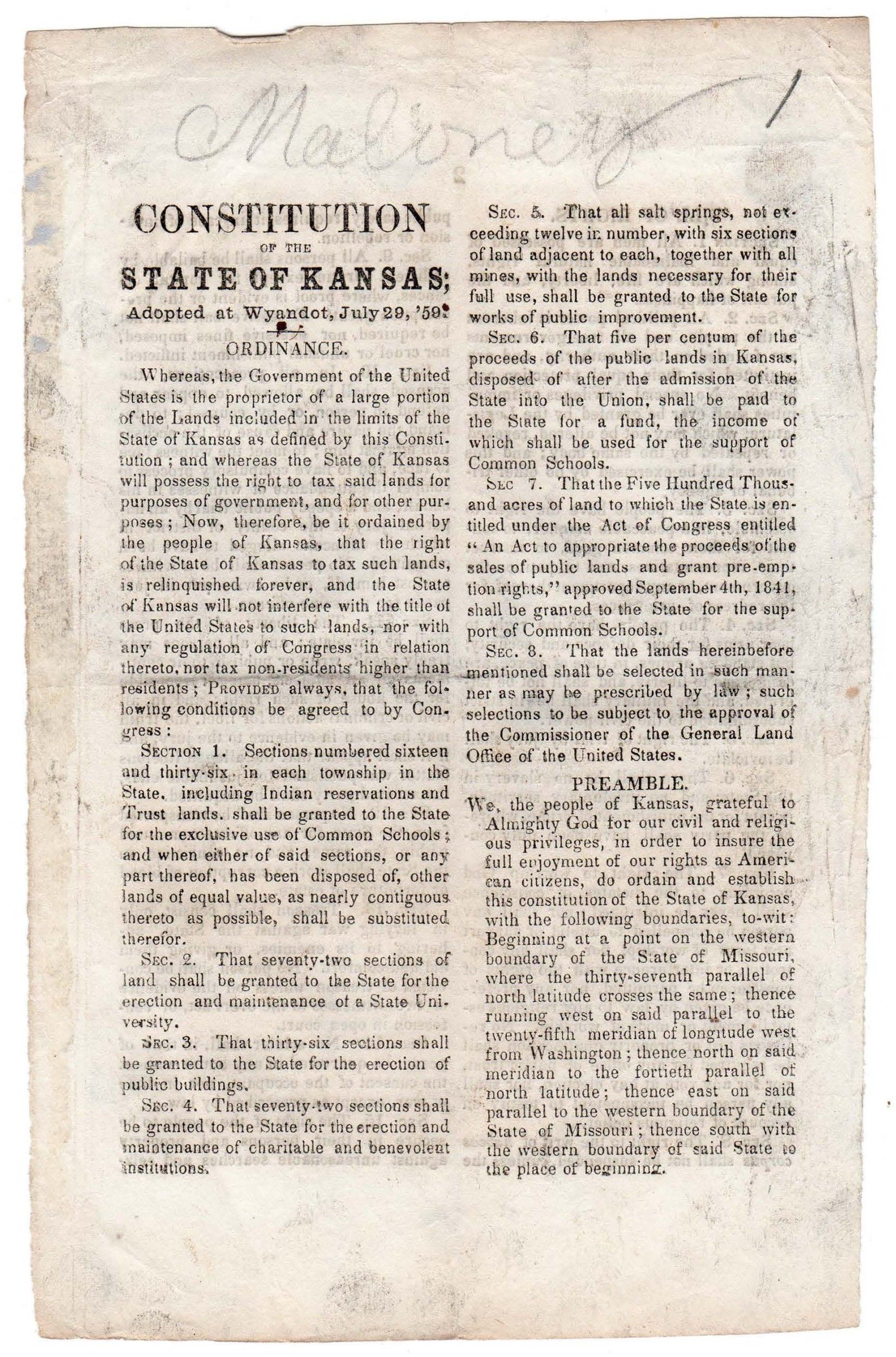
Wyandot Constitution
Source: NARA’s DocsTeach

Admission of West Virginia into the Union
Source: NARA’s DocsTeach
On March 16, 1862, President Abraham Lincoln made a final attempt to persuade states to gradually abolish slavery. He sent a message to Congress, stating, “I recommend the adoption of a Joint Resolution by your honorable bodies which shall be substantially as follows: ‘Resolved that the United States ought to co-operate with any State which may adopt gradual abolishment of slavery giving to such State pecuniary aid, to be used by such State, in its discretion, to compensate for the inconveniences, public and private, produced by such change of system.’” It proved a futile attempt, however, as Congress did not take up his resolution.
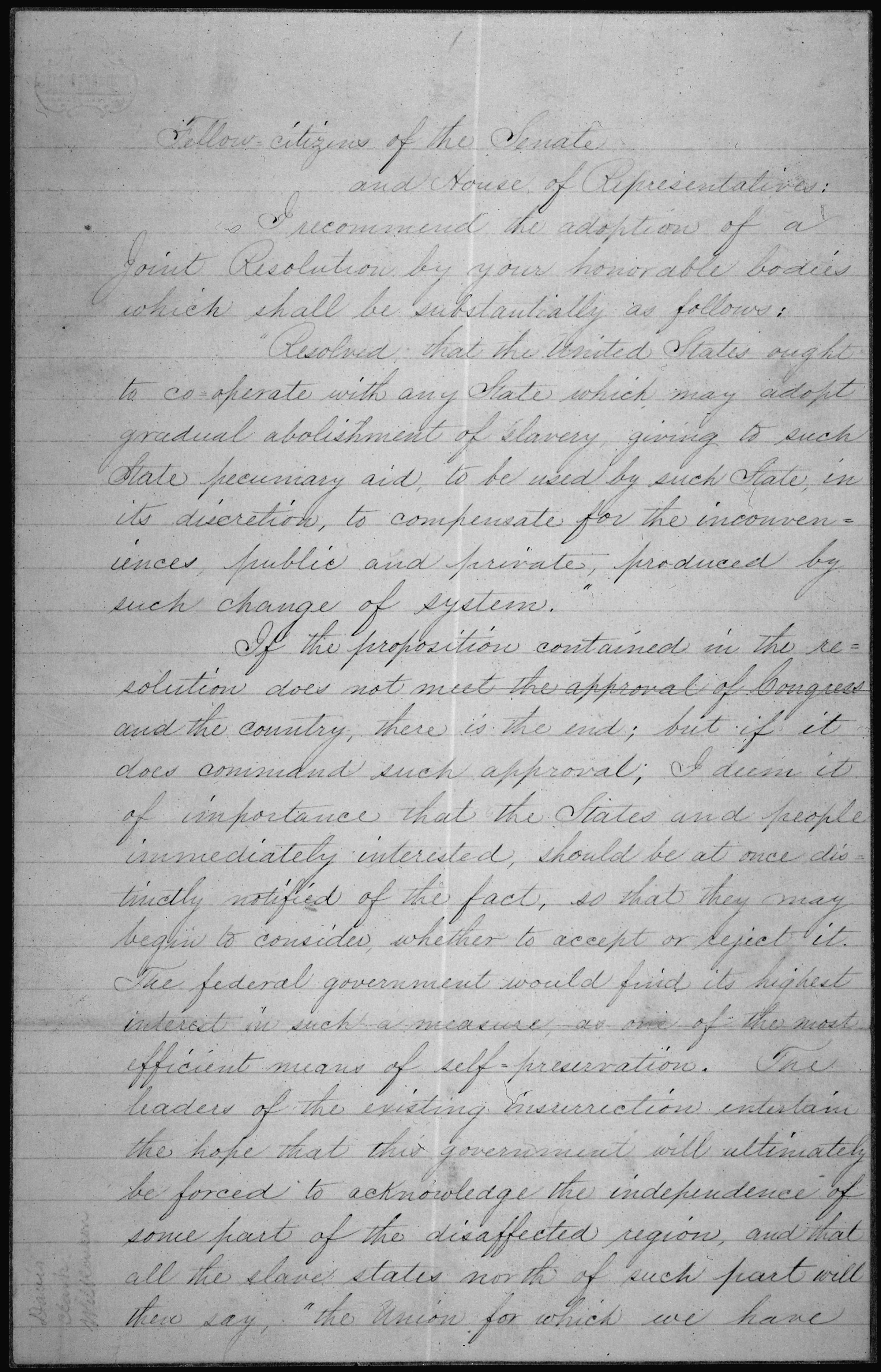
Lincoln–gradual emancipation
Source: NARA’s DocsTeach
On April 16, 1862, President Abraham Lincoln signed the District of Columbia Compensated Emancipation Act, which abolished slavery in Washington, DC, freed 3,100 people, reimbursed those who had legally owned them up to $300 for each freeperson, and offered to pay the newly freed women and men to emigrate. Senator Henry Wilson of Massachusetts sponsored the legislation. Every April 16, the district commemorates DC Emancipation Day.
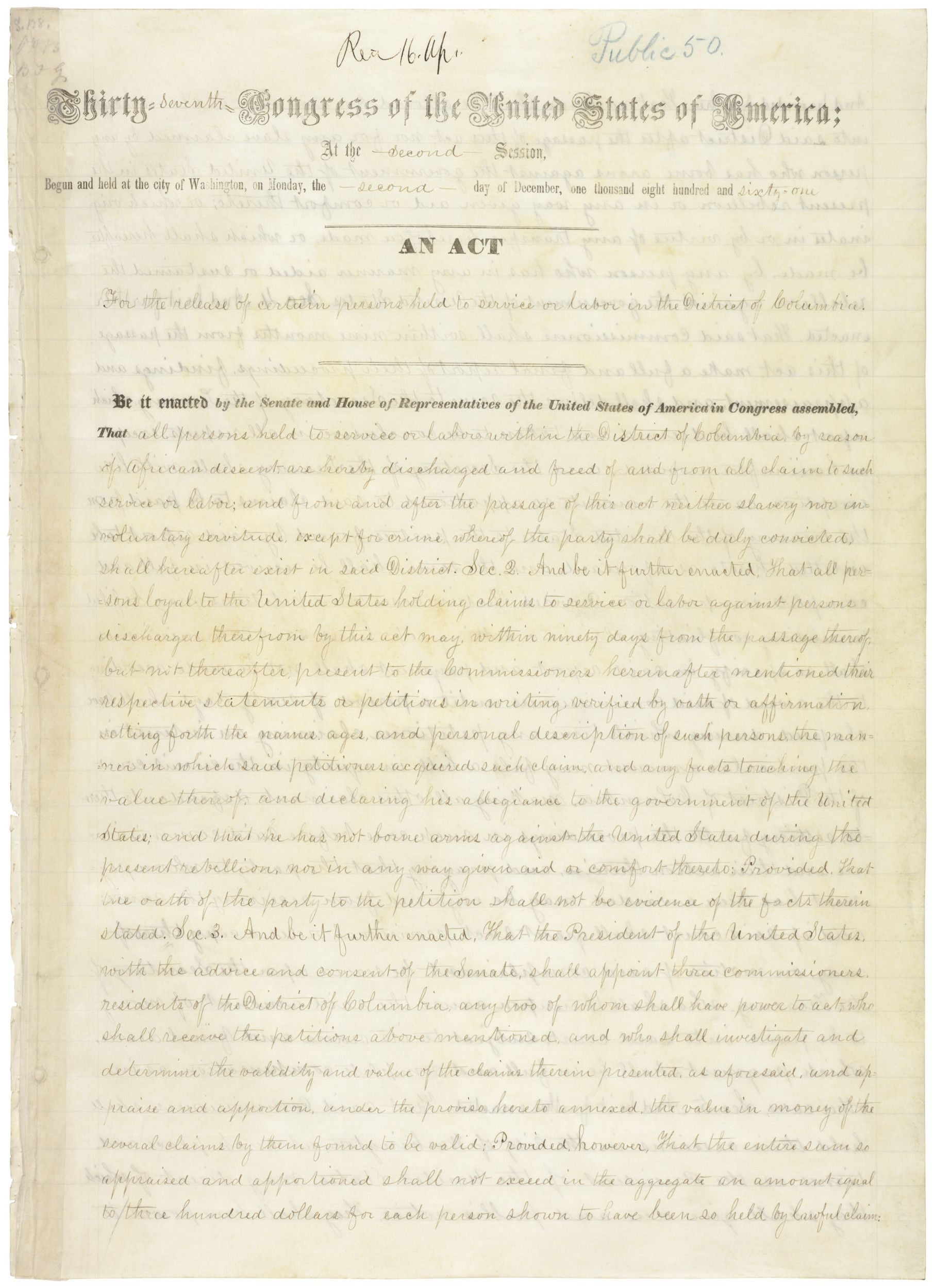
DC Compensated Emancipation Act
Source: NARA’s DocsTeach
Then on January 1, 1863, President Abraham Lincoln issued the Emancipation Proclamation, which pronounced “all persons held as slaves” within the states that had seceded from the Union “are, and henceforward shall be free.”
It is critical to remember that the Emancipation Proclamation was an act of war. Lincoln used it to free the slaves only in the states that were still in active rebellion against the Union. No slaves in Confederate states that Union troops then occupied or in border states were affected by the proclamation. And if the Union didn’t win the Civil War, the proclamation would be, quite obviously, null and void.
Even as he issued the proclamation, Lincoln himself was not entirely sure he had the legal authority to do so, but he felt it was imperative that he take the action because he felt it was critical to winning the war. He further believed that if the people of the United States felt he had acted without adequate authority, they would not reelect him in 1864. But they did send him back to the White House in a landslide decision that fall, a ringing endorsement of his leadership and of their belief in his ability to steer the ship of state to safety.

Emancipation Proclamation, January 1, 1863
National Archives Identifier: 299998
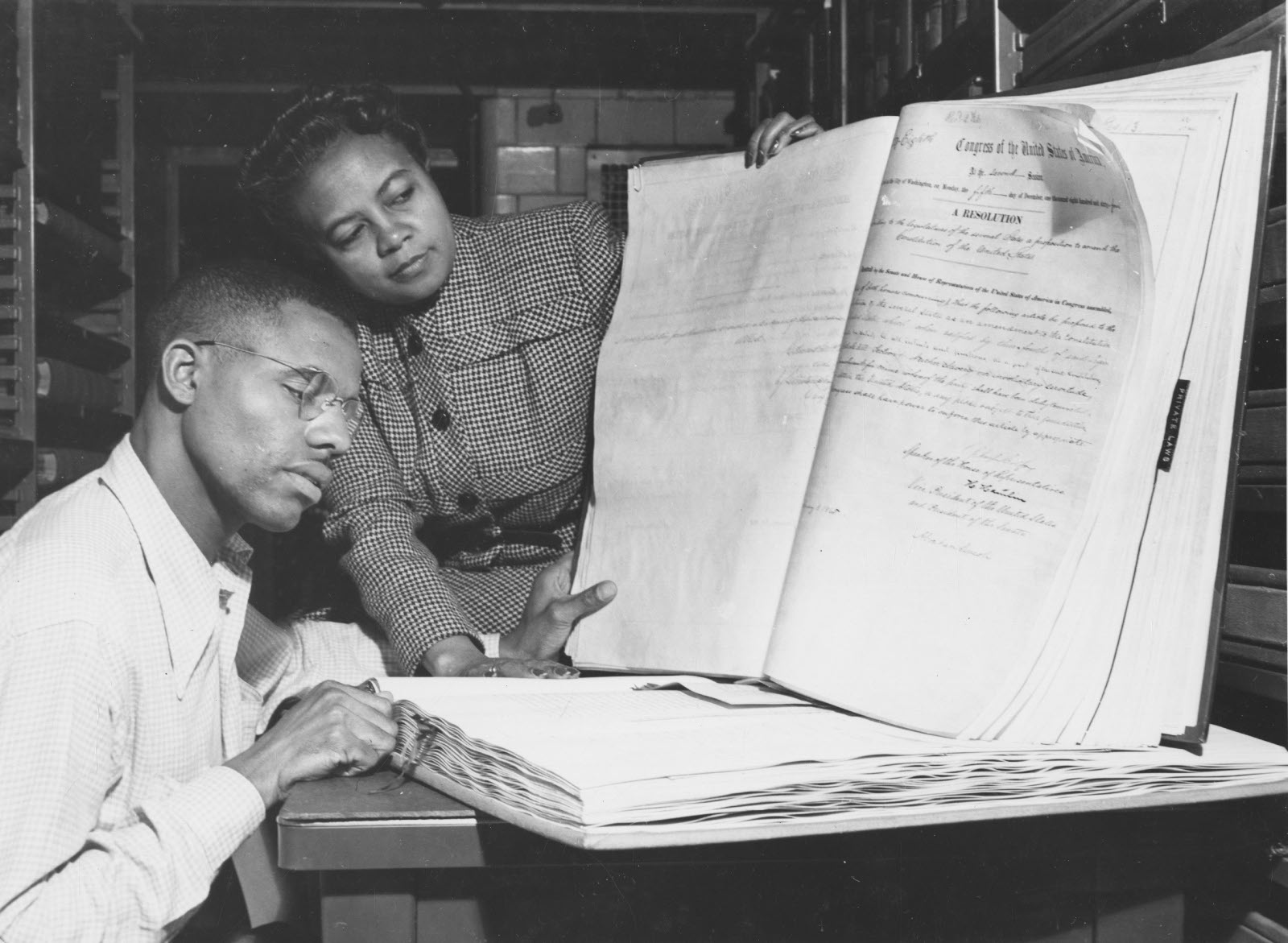
Researchers viewing the 13th Amendment, 1946
National Archives Identifier: 18519903
The 13th Amendment to the Constitution of the United States was the final word in the abolition argument, abolishing slavery for good in the United States. The Senate passed it in April 1864, but then it languished for months in the House of Representatives, until President Lincoln took a personal interest in it and insisted that it be made part of the Republican Party’s platform in the 1864 election. In January 1865, the House of Representatives passed the amendment by a vote of 119–56. On December 6, 1865, it achieved ratification by three-quarters of the states.





